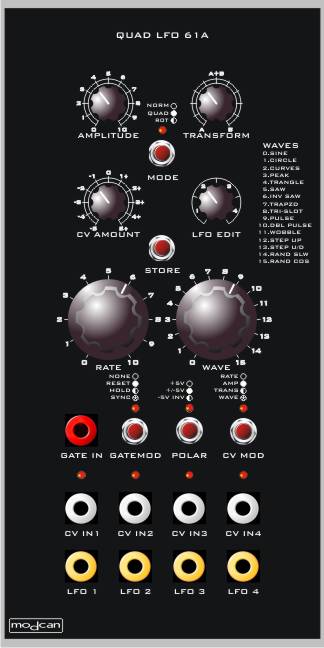-
Home
Welcome to the home of Modcan Synthesizers.
Modcan offers modules in 3 different formats.
A series is the original format with banana jacks.
B Series shares the same circuitry but uses a more
friendly rack sizing and 1/4" jacks.Euro is the newest Modcan format designed for the
Euro Rack format -
A Series
Oscillators
Cases
Filters
Envelopes
LFOs/Logic
FX
Sequencing
CV/Switching
-
B Series
Oscillators
Cases
Filters
Envelopes
LFOs/Logic
FX
Sequencing
CV/Switching
-
Euro Rack
Oscillators
Filters
Sequencer
FX
CV Processing
LFO
Envelope
- Info
- Sounds

The Quad LFO 61B is the second in a series of modules that represents a new approach in User Interface design for Modcan modules. The intent is to combine multiple iterations of otherwise single module functions, in this case an LFO, into a high density module with large feature set that maximizes panel space and control hardware.
Here is what it would look like if all the functions of this module where available on the front panel and 8U wide!!

- Features:
- 12bit DAC, step free throughout 500Hz - 0.008Hz range
- 16 unique waves, see manual HERE for more details
- All waves have some form of transformation available.
- Four different Modulation destinations per LFO.
- Three different Gate Modes per LFO.
- Tempo Sync with divide is available to set LFO Rate using a clock.
- Three Global Modes of operation: Normal, Quadrature and Rotate.
- Three Modes for output wave polarity. +/-5V, 0-5V+, Inverted.
- Memory storage to save user configuration.
User Interface:
This design uses a "paging" interface with four individual LFOs that are edited by a common set of 6 panel control knobs and 5 switches. The LFO EDIT knob selects one of four LFOs to edit. The knobs become "live" for that channel with the final edit settings stored to non-volatile internal EEprom memory. All settings are automatically restored on power up.
Three global modes of operation:
Normal: Each LFO is is edited individually. All Modulation routings and RESET options are controlled by panel switch settings and knobs and stored to memory.
Quadrature: Only one LFO is active but the other three outputs are 90,180,270 degrees out of phase with the primary out. This is great for quadraphonic panning using a 4VCA or Quad cross fading of four
signals. Can also be used to sequence envelopes and a variety of other unique patches.
Rotate: This mode rotates the 4 LFOs to the 4 outputs A pulse/clock train on the GATE IN jack increments the outputs one jack to the right with each new pulse. The LFOs can be edited and all modulation routings and settings are retained. The Status LEDs remain static to help with editing.
This can produce some truly chaotic patches with a vast array of modulation possibilities.
Modulation Destinations:
Each LFO has a CV input for modulation. The CV input is routed to the 4 modulation destination by the CV MOD switch. Destination are RATE, AMPLITUDE, TRANFORMATION and WAVE selection.
All 4 destinations can be assigned and used simultaneously on all 4 channels.
GATE MOD functions:
A unique set of functions is available using the GATE MOD input.
One GATE MOD setting is available per LFO.
None: Gate has no effect on channel
Reset: Gate high resets the LFO to start position 0
Hold: Gate high holds or freezes the current LFO wave state till goes low
resuming oscillation from the hold state.
Sync:Very unique feature that synchronizes LFO Rate to an external clock or other LFO. This is a great method of keeping LFOs in sync with sequencers etc. In SYNC MODE the RATE knob is used to set the
sync division from 1-10 of the input clock. Each LFO can be set to a different division value creating a very powerful rhythmic source that can used to generate a wide variety of synchronized modulation sequences
and beat patterns. Also SYNC division is Voltage controllable allowing division variable to be modulated by external or other LFO channels for even more complex patterns.
Specifications:
Output sample rate: 20kHz@12bit
Output: 0 - 5V,+/-5V, 0-5V-@1Kohms
Input CV: +/-5V @100Kohms
Gate Inputs: +4V @100Kohms
Current Requirements:
+15V @110mA
-15V @35mA
Please view Quad LFO Manual pages for more information
Demo MP3s
Demo 1
Demo 2
Demo 3
Demo 4
Demo 5
Demo 6
Demo 7
Demo 8
Demo 9
Demo 10
Demo 11
Rotate and Sync Examples:
Sync Division examples:
All examples were performed with only the Quad LFO, 1 x VCO,
1 section of 4VCA and One envelope generator. No effects or sequencing.
The main clock was supplied by the LFO itself. The other channels were sync divided from the main channel.